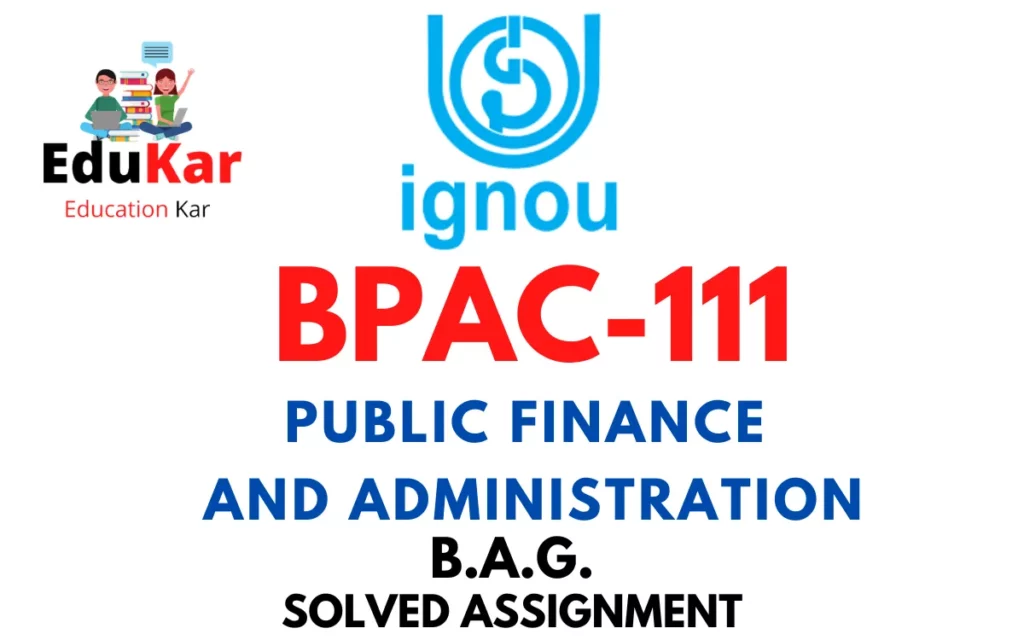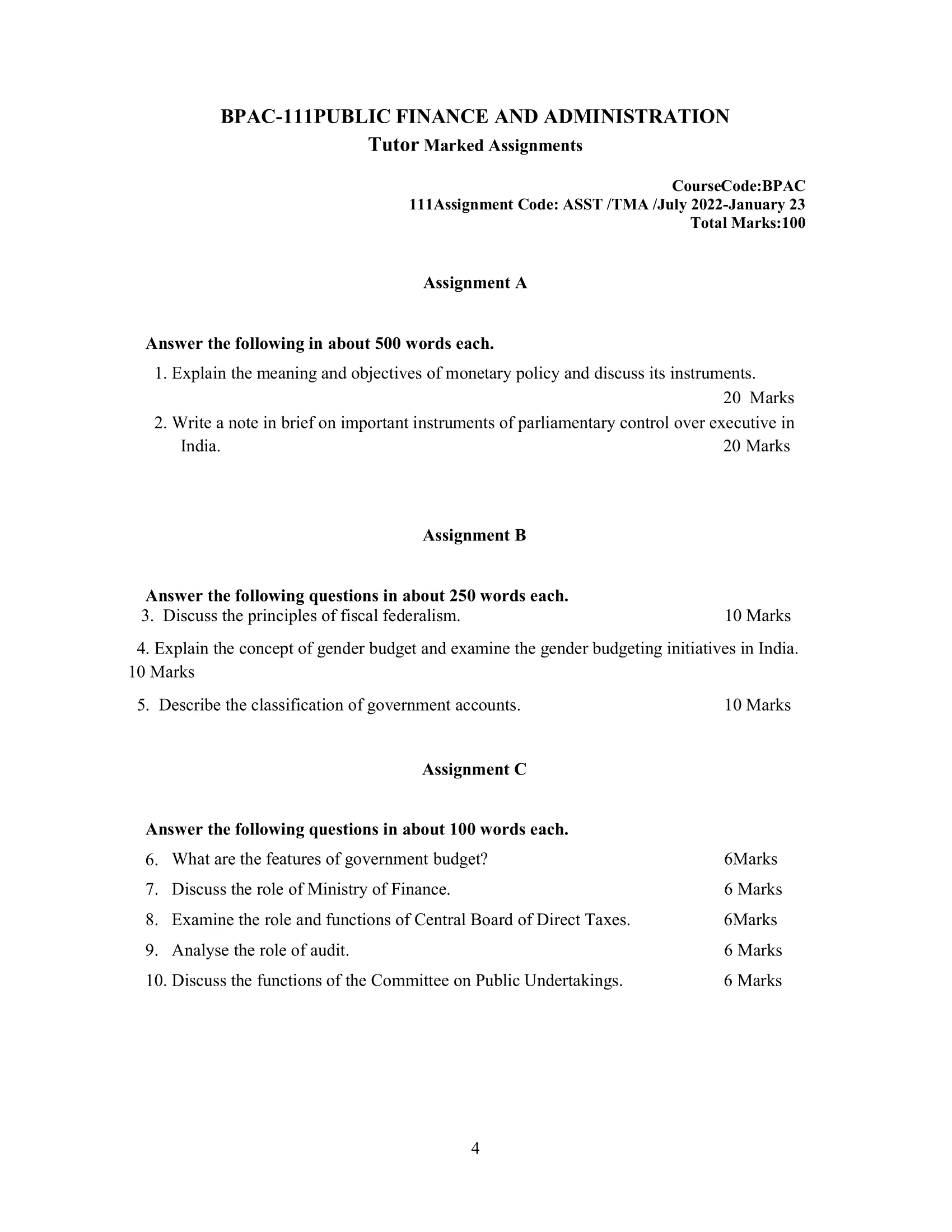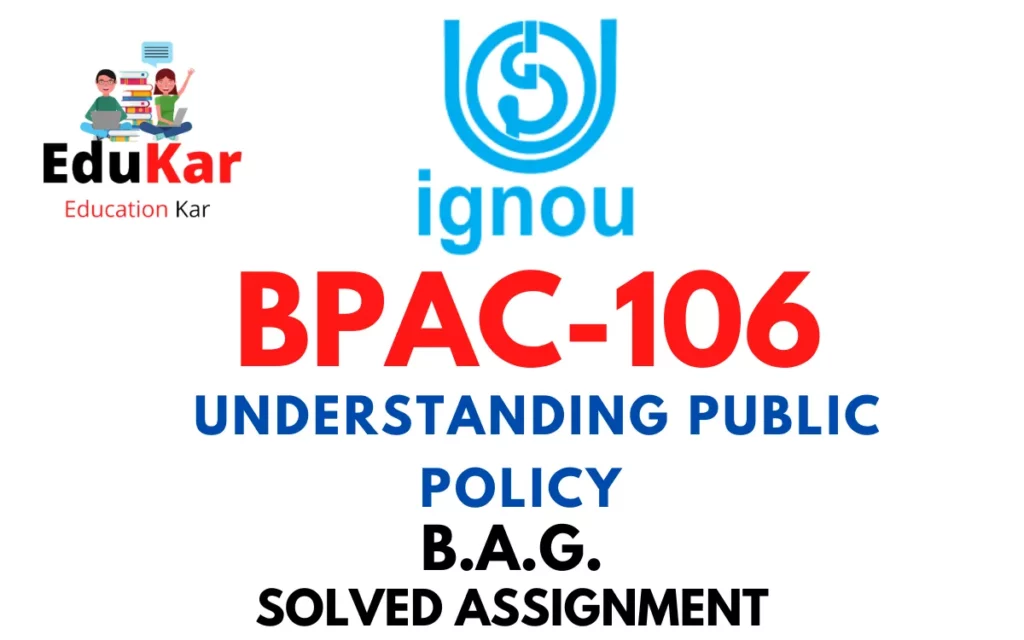Contents
- 1 Assignment A
- 2 Answer the following in about 500 words each.
- 3 1. Explain the meaning and objectives of monetary policy and discuss its instruments.
- 4 2. Write a note in brief on important instruments of parliamentary control over executive in India.
- 5 Assignment B
- 6 Answer the following questions in about 250 words each.
- 7 3. Discuss the principles of fiscal federalism.
- 8 4. Explain the concept of gender budget and examine the gender budgeting initiatives in India.
- 9 5. Describe the classification of government accounts.
- 10 Assignment C
- 11 Answer the following questions in about 100 words each.
- 12 6. What are the features of government budget?
- 13 7. Discuss the role of Ministry of Finance.
- 14 8. Examine the role and functions of Central Board of Direct Taxes.
- 15 9. Analyse the role of audit.
- 16 10. Discuss the functions of the Committee on Public Undertakings.

| Title | BPAC-111: IGNOU BAG Solved Assignment 2022-2023 |
| University | IGNOU |
| Degree | Bachelor Degree Programme |
| Course Code | BPAC-111 |
| Course Name | PUBLIC FINANCE AND ADMINISTRATION |
| Programme Name | Bachelor of Arts (General) |
| Programme Code | BAG |
| Total Marks | 100 |
| Year | 2022-2023 |
| Language | English |
| Assignment Code | ASST /TMA /July 2022-January 23 |
| Assignment PDF | Click Here |
| Last Date for Submission of Assignment: | For June Examination: 31st April For December Examination: 30th September |

Assignment A
Answer the following in about 500 words each.
1. Explain the meaning and objectives of monetary policy and discuss its instruments.
Ans: Monetary policy refers to the actions taken by a central bank to control the money supply and influence interest rates in order to achieve macroeconomic objectives, such as price stability, full employment, and sustainable economic growth. The primary objective of monetary policy is to maintain price stability, which is achieved through managing inflation by adjusting interest rates and the money supply. In addition to price stability, monetary policy can also help to promote economic growth, stability in the financial system, and full employment.
The main instruments of monetary policy include:
- Open market operations: This involves the buying and selling of government securities by the central bank to control the money supply. If the central bank buys securities, it injects money into the economy, and if it sells securities, it withdraws money from the economy.
- Reserve requirements: The central bank can require commercial banks to hold a certain amount of reserves, which limits the amount of money they can lend out. If the reserve requirement is increased, banks will have to hold more reserves, which reduces the amount of money they can lend.
- Discount rate: The discount rate is the interest rate at which commercial banks can borrow money from the central bank. By changing the discount rate, the central bank can influence the interest rates that commercial banks charge their customers.
- Interest on reserves: The central bank can pay interest on reserves held by commercial banks, which can influence the amount of money they lend out.
- Forward guidance: The central bank can use forward guidance to influence expectations about future interest rates and economic conditions. For example, by announcing that interest rates will remain low for an extended period, the central bank can encourage borrowing and investment.
The choice of instrument used by a central bank will depend on its policy goals and the prevailing economic conditions. For example, during a period of low economic growth, the central bank may use open market operations to inject more money into the economy and reduce interest rates to stimulate borrowing and investment. Conversely, during a period of high inflation, the central bank may increase the reserve requirement or raise interest rates to reduce the money supply and control inflation.
2. Write a note in brief on important instruments of parliamentary control over executive in India.
Ans: In India, the Constitution provides for a system of checks and balances to ensure that the executive branch of government remains accountable to the legislature. The legislature, comprising the Lok Sabha (the lower house) and the Rajya Sabha (the upper house), is responsible for overseeing the actions of the executive branch and ensuring that it acts in the best interests of the people. Some of the important instruments of parliamentary control over the executive in India are:
- Question Hour: During the question hour, members of the Parliament can ask questions of ministers and hold them accountable for their actions. This provides a platform for the legislature to scrutinize the executive and ensure that it is acting in the best interests of the people.
- Parliamentary Committees: The Parliament of India has several standing committees, such as the Public Accounts Committee and the Estimates Committee, that are responsible for examining the budget, scrutinizing the actions of the executive, and making recommendations to the government. These committees can summon officials and ministers to give evidence, and they provide a platform for detailed scrutiny of government policies and actions.
- Motions: Members of Parliament can use various types of motions, such as no-confidence motions, adjournment motions, and calling attention motions, to hold the government accountable for its actions. These motions allow members to debate and vote on issues of concern, and they can be used to force the government to explain its actions or to express disapproval of government policies.
- Resolutions: Resolutions are formal expressions of the opinion of the House on a particular issue. They are not binding on the government, but they can be used to make a political point or to draw attention to an issue of concern.
- Debates: Debates are an important tool for holding the government accountable and for expressing the views of members of Parliament. They provide a platform for members to express their views and to question government policies.
- Impeachment: The Constitution provides for the impeachment of the President, Vice-President, and Judges of the Supreme Court and High Courts. Impeachment is a formal process that requires a two-thirds majority in both Houses of Parliament, and it can be used to remove officials who have committed a serious violation of the Constitution or who have acted in a manner that is prejudicial to the interests of the country.
Assignment B
Answer the following questions in about 250 words each.
3. Discuss the principles of fiscal federalism.
Ans: Fiscal federalism is a system of resource allocation and distribution between different levels of government in a federal system. The principles of fiscal federalism aim to ensure that resources are allocated efficiently and effectively among different levels of government. There are several principles of fiscal federalism, including:
- Decentralization: The principle of decentralization involves the transfer of power and authority from the central government to regional and local governments. Decentralization is a critical aspect of fiscal federalism as it promotes accountability, responsiveness, and local ownership of public policies and programs.
- Autonomy: Fiscal federalism requires that each level of government has financial autonomy, which means that they have control over their own revenues and expenditures. This autonomy helps ensure that each level of government can make decisions that align with the needs and priorities of their constituents.
- Equity: The principle of equity requires that resources are allocated in a fair and just manner. This means that there should be a balance between the needs of different levels of government and that resources should be allocated based on objective criteria.
- Coordination: Fiscal federalism also requires coordination among different levels of government to ensure that policies and programs are implemented effectively. Coordination is important to avoid duplication, reduce transaction costs, and improve efficiency.
- Subsidiarity: The principle of subsidiarity holds that decisions should be made at the lowest possible level of government. This means that decisions should be made by the level of government closest to the people, which is often the local or regional government.
Overall, the principles of fiscal federalism seek to promote efficient, effective, and equitable resource allocation and distribution among different levels of government. These principles are important in ensuring that public policies and programs meet the needs and priorities of citizens in a federal system.
However, it is important to note that the implementation of these principles can be complex and challenging, particularly when there are overlapping responsibilities and competing priorities between different levels of government. Effective fiscal federalism requires continuous communication, collaboration, and negotiation among different levels of government to ensure that resources are allocated in a way that maximizes social welfare.
4. Explain the concept of gender budget and examine the gender budgeting initiatives in India.
Ans. Gender budgeting is an approach to public finance management that aims to identify and address the differential impact of government budgets on women and men. It involves assessing the gender-differentiated impact of government expenditures and revenues, with the goal of promoting gender equality and women’s empowerment. The concept of gender budgeting is based on the recognition that government budgets have a significant impact on gender relations and the distribution of resources between men and women.
In India, gender budgeting initiatives were introduced in 2001 with the objective of addressing gender-based inequalities in public resource allocation. The Ministry of Finance introduced the Gender Budget Statement, which provides a separate statement of all gender-related allocations in the Union Budget. The Gender Budget Statement includes allocations for gender-specific schemes and programs, as well as gender mainstreaming initiatives across sectors.
The Gender Budget Statement in India covers the entire gamut of government expenditure, including education, health, employment, infrastructure, and social security. It provides a comprehensive picture of gender-specific allocations in government spending and helps to track progress towards gender equality. The Gender Budget Statement is also accompanied by the Gender Budgeting Guidelines, which provide a framework for gender analysis in budgeting and promote gender mainstreaming in policies and programs.
One of the key initiatives under gender budgeting in India is the Mahila E-Haat, which is an online marketplace for women entrepreneurs. The initiative was launched by the Ministry of Women and Child Development to provide a platform for women to showcase their products and services and to promote women’s economic empowerment.
Another gender budgeting initiative in India is the Beti Bachao Beti Padhao (BBBP) program, which aims to improve the sex ratio and promote the education of girls. The program includes a range of interventions, including cash incentives for families that have a girl child, awareness campaigns, and support for the education of girls.
5. Describe the classification of government accounts.
Ans: Government accounts are classified based on the type of transaction, the nature of the account, and the type of fund. The classification of government accounts helps to provide a clear understanding of government financial transactions, aids in the monitoring and control of government expenditures, and supports the preparation of financial reports. Here are the three main types of classifications of government accounts:
- By type of transaction: Government accounts are classified based on the type of transaction. This classification includes revenue, expenditure, and capital transactions. Revenue transactions refer to inflows of funds to the government, such as taxes, fees, and fines. Expenditure transactions refer to outflows of funds from the government, such as salaries, supplies, and other operating expenses. Capital transactions refer to the acquisition or disposal of assets, such as land, buildings, or equipment.
- By nature of the account: Government accounts are classified based on the nature of the account, such as personal, impersonal, or memorandum accounts. Personal accounts record the transactions of individuals or organizations that have a direct relationship with the government, such as employees, vendors, or creditors. Impersonal accounts record transactions that do not have a direct relationship with individuals or organizations, such as taxes, fees, or interest. Memorandum accounts are used to record transactions that do not affect the government’s financial position, such as advances or deposits.
- By type of fund: Government accounts are classified based on the type of fund, such as general, special, or trust funds. The general fund is the primary fund used for day-to-day government operations, such as salaries, supplies, and other operating expenses. Special funds are used for specific purposes, such as road construction, education, or public health. Trust funds are used to hold assets for the benefit of a specific group, such as pension or retirement funds.
In addition to these classifications, government accounts may also be classified based on the accounting method used, such as cash or accrual accounting, and based on the level of government, such as national, state, or local. The classification of government accounts is an essential tool in financial management and helps to provide a clear understanding of government financial transactions.
Assignment C
Answer the following questions in about 100 words each.
6. What are the features of government budget?
Ans: The features of a government budget include:
- Annual: The government budget is prepared and presented every year to reflect the changing economic conditions and policy priorities.
- Comprehensive: The government budget covers all revenue and expenditure of the government, including taxes, subsidies, grants, capital expenditures, and debt servicing.
- Binding: The government budget is a legal document that sets out the expenditure limits and revenue targets for the coming year. It is binding on all government departments and agencies.
- Public: The government budget is a public document that is presented to the Parliament and is subject to debate and discussion by members of the legislature.
- Balanced: The government budget aims to balance the expenditure and revenue of the government, so that the fiscal deficit is kept within reasonable limits.
- Flexible: The government budget is flexible enough to respond to changing economic conditions and policy priorities. The government can revise its expenditure and revenue targets during the year, if necessary.
- Long-term planning: The government budget also includes long-term planning for capital expenditures, such as infrastructure projects and investments in education and healthcare.
7. Discuss the role of Ministry of Finance.
Ans: The Ministry of Finance is a key government department in charge of managing the economic and financial affairs of the country. Its primary role is to formulate and implement policies related to public finance, taxation, banking, and capital markets. Some of the key roles and responsibilities of the Ministry of Finance are:
- Fiscal Policy: The Ministry of Finance plays a critical role in formulating and implementing fiscal policies aimed at achieving sustainable economic growth and development. This includes setting budgetary policies, preparing the annual budget, and monitoring the implementation of budgetary measures.
- Taxation: The Ministry of Finance is responsible for formulating policies related to taxation, including income tax, corporate tax, and customs duties. It also manages the administration of tax laws, including the collection of taxes, and the enforcement of tax regulations.
- Financial Markets: The Ministry of Finance is responsible for overseeing the development and regulation of financial markets, including the stock exchange, bond markets, and foreign exchange markets. It also manages the government’s debt, including the issuance of government bonds and other securities.
- Banking: The Ministry of Finance oversees the banking sector and is responsible for formulating policies related to the regulation and supervision of banks. It also manages the government’s relationship with the central bank and other financial institutions.
- Economic Policy: The Ministry of Finance is involved in the formulation and implementation of economic policies aimed at promoting sustainable economic growth and development. It plays a key role in the development of macroeconomic policies, including monetary policy, exchange rate policies, and trade policies.
- International Finance: The Ministry of Finance is responsible for managing the country’s relations with international financial institutions, including the International Monetary Fund and the World Bank. It also plays a key role in managing the country’s external debt and international reserves.
8. Examine the role and functions of Central Board of Direct Taxes.
Ans: The Central Board of Direct Taxes (CBDT) is a statutory authority responsible for administering the direct tax laws in India. It is a part of the Department of Revenue in the Ministry of Finance, and its primary role is to ensure that the direct tax laws are implemented effectively and efficiently. The following are the key functions and roles of the CBDT:
- Formulation of Direct Tax Policies: The CBDT is responsible for formulating direct tax policies and guidelines for the collection and administration of direct taxes. It also provides clarifications on tax issues and develops strategies for tax collection and enforcement.
- Implementation of Direct Tax Laws: The CBDT is responsible for ensuring the implementation of the Income Tax Act, 1961 and other direct tax laws. It also oversees the work of the Income Tax Department, which is responsible for collecting direct taxes from individuals and businesses.
- Interpretation of Tax Laws: The CBDT interprets the tax laws and issues binding circulars and notifications to guide taxpayers and tax officials. It also provides advance rulings on tax matters for the benefit of taxpayers.
- Administration of Taxation: The CBDT administers the direct tax laws through the Income Tax Department. It supervises the functioning of tax offices and tax officials across the country, and ensures that taxpayers comply with tax laws.
- Redressal of Taxpayer Grievances: The CBDT is responsible for redressing grievances of taxpayers, such as disputes relating to tax assessments, refunds, and tax demand. It also has the power to condone delays in tax filings and payment of taxes.
- International Taxation: The CBDT plays a critical role in international taxation by signing Double Taxation Avoidance Agreements (DTAAs) with other countries. It also participates in negotiations on tax treaties and exchange of information with other countries to prevent tax evasion.
- Policy Initiatives: The CBDT is responsible for introducing new policies and initiatives related to direct taxes, such as the introduction of e-filing of tax returns, e-payment of taxes, and the Income Declaration Scheme.
9. Analyse the role of audit.
Ans: Audit plays a critical role in promoting transparency, accountability, and good governance in both public and private organizations. Here are some key roles that audit plays:
- Ensuring compliance: Audit helps to ensure that organizations comply with relevant laws, regulations, and standards. This includes financial reporting standards, tax laws, and industry-specific regulations. Audit provides an independent and objective review of an organization’s operations to identify any areas of non-compliance.
- Enhancing transparency: Audit promotes transparency by providing an independent and objective review of an organization’s financial statements, internal controls, and risk management processes. This helps to increase the level of transparency in an organization’s operations, and ensures that relevant stakeholders have access to accurate and reliable information.
- Improving governance: Audit plays a crucial role in improving the governance of organizations by providing an independent assessment of an organization’s financial management practices, risk management processes, and internal controls. Audit reports can be used by boards of directors and management to identify areas of weakness and make improvements to governance practices.
- Supporting decision-making: Audit reports can provide valuable insights that support decision-making by management and other stakeholders. For example, audit reports can highlight areas of risk, inefficiencies, or opportunities for improvement, which can help management to make informed decisions about resource allocation and operational priorities.
- Enhancing credibility: Audit enhances the credibility of an organization’s financial statements by providing an independent and objective assessment of the accuracy and completeness of financial information. This can help to increase stakeholder confidence in an organization’s financial reporting and governance practices.
10. Discuss the functions of the Committee on Public Undertakings.
Ans: The Committee on Public Undertakings (COPU) is a parliamentary committee in India that oversees the functioning of public sector enterprises. The primary functions of COPU are to examine the reports and accounts of public sector undertakings, assess their financial and operational performance, and make recommendations for their improvement. The committee also evaluates the efficiency and effectiveness of public sector enterprises in achieving their objectives, and reviews the implementation of government policies and guidelines. Additionally, COPU scrutinizes the process of appointment and removal of board members and key executives in public sector enterprises. The committee plays a crucial role in promoting transparency, accountability, and good governance in public sector enterprises, and helps to ensure that they operate in the best interests of the public.
How to Download BPAC-111 Solved Assignment?
You can download it from the www.edukar.in, they have a big database for all the IGNOU solved assignments.
Is the BPAC-111 Solved Assignment Free?
Yes this is absolutely free to download the solved assignment from www.edukar.in
What is the last submission date for BPAC-111 Solved Assignment?
For June Examination: 31st April, For December Examination: 30th October















